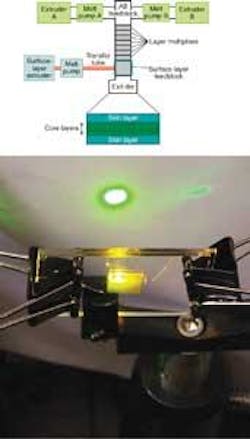ORGANIC LASERS: Polymer DBR lasers move toward roll-to-roll production

Polymer lasers are attracting attention for their potential processing advantages and the ability to broadly tailor wavelength output based on simple dopant and material modifications. Unfortunately, most polymer or organic lasers are still processed using rather complex embossing, nanoimprinting, lithography, or spin-coating steps. The ultimate goal of many organic optoelectronic devices is low-cost roll-to-roll processing. Toward that end, researchers at the National Science Foundation-sponsored Center for Layered Polymer Systems (CLiPS) at Case Western Reserve University (Cleveland, OH) and Youngstown State University (Youngstown, OH), have demonstrated all-polymer optically pumped distributed-Bragg-reflector (DBR) lasers fabricated from layers created with an extrusion process that lends itself to high-throughput roll-to-roll production methods.1
Multilayer polymer mirrors
The polymer laser in its final form consists of an active layer of a dye-doped host polymer sandwiched between two reflector layers, each consisting of 128 alternating layers of polymethylmethacrylate (PMMA) and polystyrene (PS). Even though the assembled laser was then pressed between two glass slides (with the various layers index-matched using silicon oil to assess device performance), the more notable fabrication steps include the melt-processed DBR layers and the gain layer.
To fabricate the DBR material, a layer-multiplying coextrusion process is used. A PMMA polymer melt and a separate PS polymer melt are fed into a coextrusion feedblock and then into a series of six multiplying elements, each of which slices the melt vertically, spreads it horizontally, and recombines it to double the number of layers (see figure). Just before the layered material exits the dye, a removable polyethylene skin material is applied to smooth the spreading forces to create a more uniform, higher-quality reflection film. The different indices of refraction of PMMA (1.489 ± 0.002) and PS (1.585 ± 0.002) create a sharp reflection band that is matched to the peak emission wavelength of the central gain medium of the DBR laser by controlling layer thickness through the extrusion process and with biaxial stretching of the film.
The gain media were prepared as compression-molded thin films of glassy amorphous host polymers doped with fluorescent dyes such as rhodamine 6G perchlorate. The polymer processing steps can be modified to create different layer thicknesses of different polymer and polymer-doped materials to achieve targeted lasing output profiles and wavelengths.
When assembled as a sandwich of cover glass/reflective layer/active layer/reflective layer/cover glass, the optically pumped DBR laser modes had a spectral width (full width at half maximum) of 0.4 nm—near the resolution of the measurement instrumentation. The highest energy-conversion efficiency of the lasers fabricated was 19.3% for a rhodamine 6G sample with a 40-µm-thick PMMA gain layer.
“Although the construction of the DBR laser can be transformed into a roll-to-roll-process using two multilayer coextruders, a gain-layer extruder, and a laminating roll, we are now focusing on incorporating the gain medium into the multilayer film to produce a distributed-feedback laser that can be made using a single multilayer coextruder,” says Kenneth Singer, professor of physics and macromolecular science and engineering at Case Western Reserve University. “We are also investigating the use of semiconducting materials as more-stable gain media.”
REFERENCE
1. K.D. Singer et al., Optics Express 16(14) 10358 (July 7, 2008).

Gail Overton | Senior Editor (2004-2020)
Gail has more than 30 years of engineering, marketing, product management, and editorial experience in the photonics and optical communications industry. Before joining the staff at Laser Focus World in 2004, she held many product management and product marketing roles in the fiber-optics industry, most notably at Hughes (El Segundo, CA), GTE Labs (Waltham, MA), Corning (Corning, NY), Photon Kinetics (Beaverton, OR), and Newport Corporation (Irvine, CA). During her marketing career, Gail published articles in WDM Solutions and Sensors magazine and traveled internationally to conduct product and sales training. Gail received her BS degree in physics, with an emphasis in optics, from San Diego State University in San Diego, CA in May 1986.